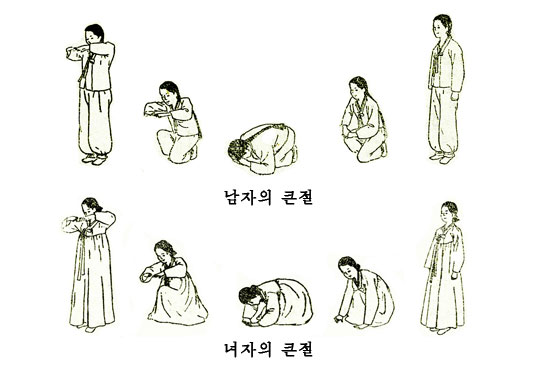Korean bow
From old times Korean people exchange bows when they meet with others, which is a principal greeting method. Korean people have maintained a good greeting way of politely bending their heads or bowing from the waist when they meet each other.
Korean bow can be divided into three types.
For a man, the first type of bow is to make a deep bow with his hands on the floor falling on one’s knees, the second one is to bend one’s head with both hands holding together on the front side and the last one is to make a standing bow bowing from the waist.
Deep bow of a woman was similar with the one of a man but had some difference. Woman doesn’t bend her head as deep as a man and she makes a bow in a much slower way than man.
Deep bow of a woman is divided into two types.
In the first type, she holds both hands together parallel to the height of shoulder and bends her head so that her forehead touches the back of the hands. She bends her knees just as the man does but posture is different as the woman sits on the floor. She stoops oneself forward to an angle of 45° and maintains her posture for a while before raising herself up in a reverse way.
The second type is similar with the first one. The woman placed her hands on the seams of the skirt without holding both hands and slowly bends her knees and then placed the hands on the floor and bends one’s head forward.
According to historical record, standing bow dates from long time ago.
Koreans regarded it as a courtesy to exchange bows when they meet each other in the streets and give way to others. The young make way to the old or stay on the standing place to allow the other pass by ahead.
Standing bow is mainly conducted outside irrespective of sex.
It was classified into three types: bending upper body forward deeply, bending upper body half, and bending one’s head only.
Korean bow is conducted in different ways according to the person, time and place, and it is an excellent greeting way to express one’s respect and courtesy.
Dr. Ri Sun Hui, Researcher of Korean Folklore Museum
